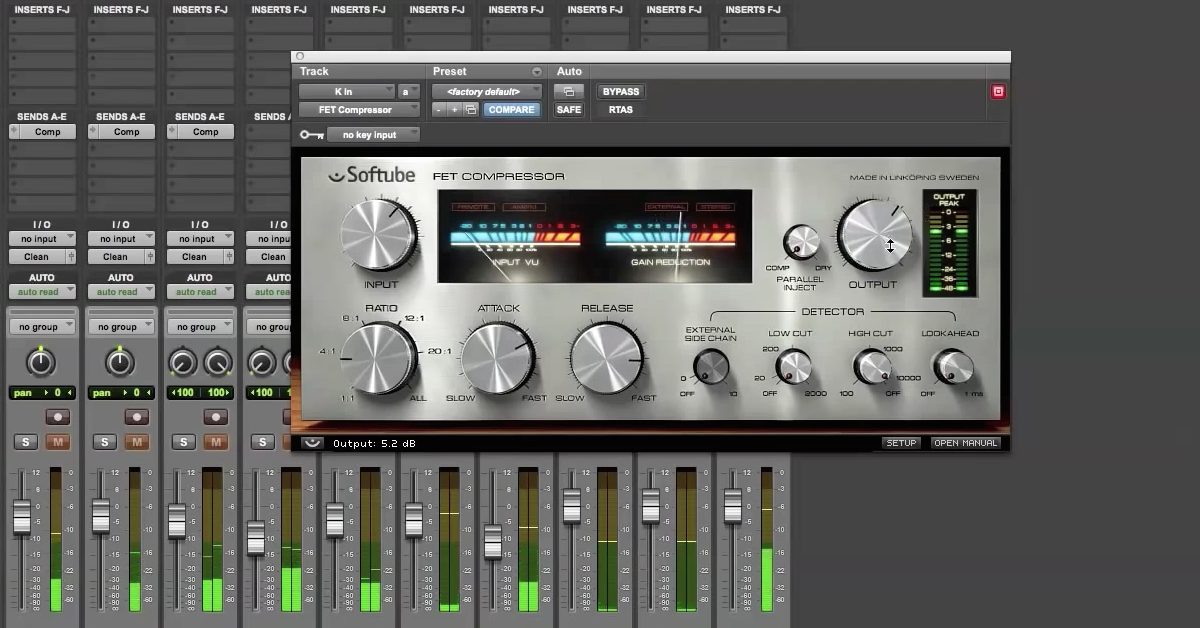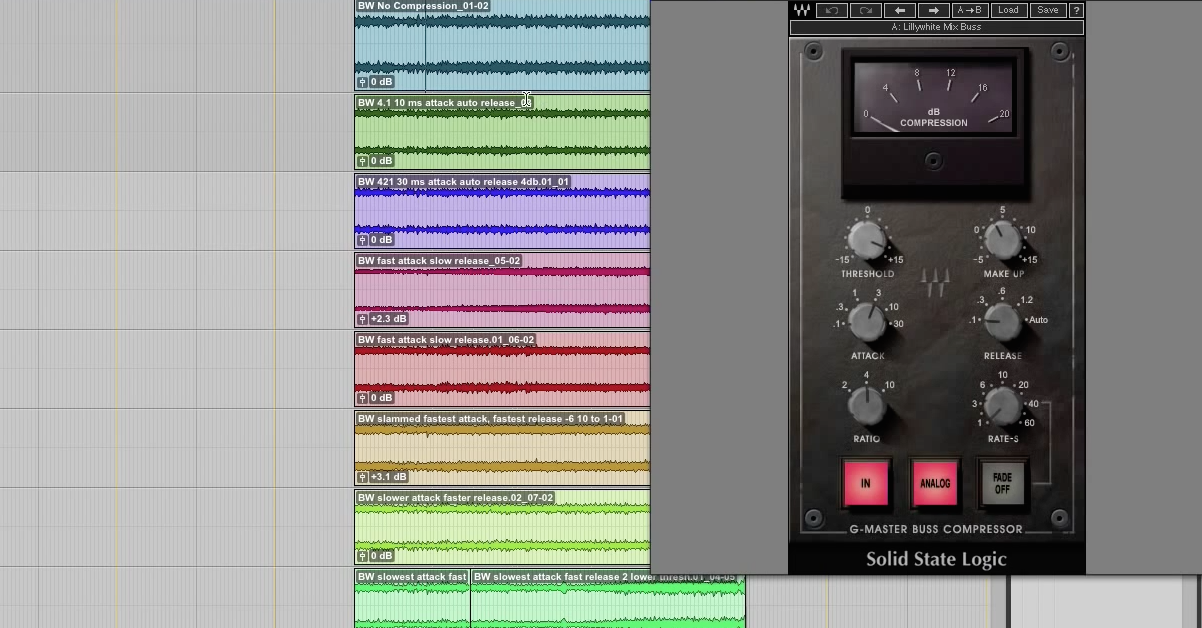7 Compressor Plugins Modeled After Analog Hardware
Article Content
Seasoned audio engineers all speak a secret language. It’s littered with seemingly random letters and numbers, like some kind of Cold War spy code. Phrases like “punch”, “bite” and “attack” are used to describe inanimate objects. They talk about “gluing”, “crushing” and “smashing” instruments.
At first, it seems shrouded in mystery. But just like any other language, as you spend time with the locals you slowly start to pick it up. Apparently, this whole time they were talking about compressors.
Most of the compressors we use today are based on analog hardware units. *But why? What’s so special about the same four basic designs?
*Author’s Note: Most, but not all. There are plenty of modern compressor plugins with unique sounds. FabFilter, Klanghelm, Kush Audio and Tokyo Dawn Records all have popular designs.
Urei 1176
The 1176 is arguably the most well-known compressor in the world. Released by Urei in 1967, it was the first “peak limiter” to use solid-state technology, instead of tubes. The 1176 uses a field-effect transistor (FET) to apply compression, which gives it a distinct “brightness, presence, and energy.”
The 1176 went through several revisions. Rev A was the original silver model with a blue stripe. Rev C was released in 1970, featured a black faceplate and increased noise reduction. Some engineers feel the Rev C models have a slower response time and increased bass response.
The controls on the 1176 are a bit quirky:
- There’s no threshold control. Instead, compression is controlled by increasing or decreasing the input knob.
- There’s no ratio knob. Instead there are four fixed ratio buttons: 4:1, 8:1, 12:1 and 20:1.
- The attack and release times are “backwards”. The slower times are to the left and the faster times are to the right.
The attack time on the 1176 is hyper-fast; 20 to 800 microseconds. It also features a variable release time. After a transient, it “releases quickly (50 mS to 1.1sec) to avoid level drops. But, if there is a continued state of heavy compression, it will exhibit a longer release to reduce pumping.”
The 1176 sounds great on many different instruments; particularly drum room mics, bass guitars and vocals. For a classic vocal sound, the Dr. Pepper setting…
Back in the 60’s, Dr. Pepper ran this ridiculous commercial suggesting that you drink a bottle at 10 am, 2 pm and 4 pm for a sugar boost. Engineers adopted the mantra when setting their 1176’s: attack knob at 10 o’clock, release at 2 o’clock and the ratio at 4:1.
Yeah, I know it makes no sense.
If you’re looking for a more aggressive sound, try the “British Mode” setting. Instead of pushing one of the ratio buttons, PUSH ALL THE BUTTONS! This increases the amount of compression and distortion applied to the signal. It’s great for crushing tracks in parallel or adding grit to help something cut through the mix.
The 1176 has more plugin emulations than any other compressor — over 20! Rev A, Rev C, vintage, modern and totally unique versions of the 1176 have been modeled by Antelope Audio, McDSP, PSP Audio, Slate Digital, Softtube, Universal Audio and Waves to name a few.
Teletronix LA-2A / 3A
The 1176 and the LA-2A are like yin and yang. Think of the 1176 as chocolate and the LA-2A as peanut butter — smooth and creamy. They’re known to “warm things up and EQ all the warmth and low mids and bass.”
The LA-2A is a Leveling Amplifier and an optical tube compressor. It uses a tube to apply compression, and an optical photocell to detect the incoming signal. The louder the signal, the brighter the light and the more compression is applied.
That’s why the LA-2A has such a simple design. Only two knobs — make-up gain and peak reduction (threshold). It also has a fixed attack time of 10ms, and fixed ratios of 4:1 in compression mode or 10:1 in limit mode.
The release time is fixed as well, but it’s more complicated. Depending on the previous program material, the release time is about 60 ms for 50% of the release, and 0.5 to 5 seconds for full release.
The first LA-2A units were produced by Teletronix in the early 60s. In 1969, they released the LA-3A — a solid-state version of the LA-2A. For the most part, the LA-3A was a pretty faithful recreation, although it has a faster attack time with larger transients.
Popular versions of the LA-2A and LA-3A have been modeled by McDSP, PSP Audio, Universal Audio and Waves.
Tube-Tech CL 1B
The LA-2A is a legendary compressor, but it doesn’t offer a lot of flexibility. It’s a bit of a “one-trick pony.” So, in 1987 Tube-Tech had a new take on the optical compression method.
The CL 1B is essentially an LA-2A with variable knobs:
- Threshold
- Ratio (2:1 to 10:1)
- Attack (0.5 to 300 ms)
- Release (.05 to 10 sec)
A unique feature of the CL 1B are the attack and release times. Not just the variable knobs but the fixed/manual switch, which offers three different settings:
- Fixed: Attack 1 ms, Release 50 ms
- Manual: Attack from 0.5 ms to 300 ms, Release from 0.05 sec to 10 sec
- Fix/man: Attack 1 ms, Release from 0.05 sec to 10 sec
The CL 1B sounds particularly great on vocals. Some engineers choose to combine the 1176 and LA-2A sounds, while others just use a CL 1B. It’s described as “warm, smooth and transparent.”
Popular versions of the CL 1B have been modeled by McDSP, PSP Audio, Softube, Universal Audio and Waves.
Fairchild 660/670
Fairchild compressors are the heaviest, oldest and most expensive analog compressors on the market. Released in the late 50s, these tube compressors came in two forms — the 660 mono version and the 670 stereo version.
Fairchild compressors use variable-mu compression techniques, which means the ratio “changes dynamically in response to the signal level. The result is a unique form of soft-knee compression which responds differently depending on the type of signal which is fed into it.”
Fairchilds may look intimidating, but the controls are essentially the same as on any other compressor. There’s no ratio control, so dial in the amount of compression using the input and threshold controls. The ratio actually increases exponentially with the amount of compression applied. “Gain reduction starts between 1:1 and 2:1 for smaller peaks and gradually increases to a ratio of up to 20:1 on loud input signals.
The “time constraint” knob controls the attack and release times simultaneously. Here are the attack and release times for each position:
- 1: 0.2 ms, 0.3 sec
- 2: 0.2 ms, 0.8 sec
- 3: 0.4 ms, 2 sec
- 4: 0.8 ms, 5 sec
- 5: 0.4 ms, 2 sec (peaks), 10 sec (multiple peaks)
- 6: 0.2 ms, 0.3 sec (peaks), 10 sec (multiple peaks), 25 (programme material)
Perhaps the most unique feature of the 670 compressor is the Left/Right – Lat/Vert switch. In addition to operating in stereo, the 670 can also operate as a mid/side compressor, with different settings for each.
Fairchild compressors are known for the transparent, natural peak limiting and are sometimes described as pristine. However, they’re also a bit of a “one-trick pony”. Even with 5 different time constraint settings, they all basically boil down to slow attack/long release. These settings can be great for vocals, bass and even the mix bus, depending on the genre.
Popular versions of the 660/670 have been modeled by Antelope Audio, McDSP, Slate Digital, Universal Audio and Waves.
Manley Vari-Mu
In 1991 Manley Labs released their version of a variable-mu compressor. Designed to rival the legendary Fairchild design, the Vari-Mu is known for it’s “remarkably transparent sheen and silk” and often described as “thick, warm, almost syrupy sounding.”
Controls include input and output gain, as well as a Left/Right – Mid/Side switch just like the Fairchild unit.
The Vari-Mu also features a comp/limit switch. When in Compress mode, the unit uses a soft-knee with a 1.5:1 ratio. When in Limit mode, the unit uses a hard-knee and a 4:1 ratio. As compression amounts increase over 12dB, the ratio is increased to up to 20:1.
Unlike the Fairchild, the Manley Vari-Mu features independent attack and release knobs. The attack times are variable (ranging from 25 ms – 70 ms) and there are 5 selectable release times:
- 0.2 sec
- 0.4 sec
- 0.6 sec
- 4 sec
- 8 sec
Popular versions of the Vari-Mu have been modeled by Native Instruments, McDSP, Universal Audio and Waves.

DBX 160A
In 1971, DBX released the 160A, a VCA compressor with “a rough, warm and grainy punch.” The DBX 160 is great for adding presence and intelligibility to things like kick, snare, bass and vocals.
Controls include standard threshold, make up gain and ratio (1:1 – 1:∞) knobs. The attack and release times, however, are fixed:
- Attack Time: Program-Dependent; typically 15ms for 10dB, 5ms for 20dB, 3ms for 30dB
- Release Time: Program-Dependent; Typically 8ms for 1dB, 80ms for 10dB, 400ms for 50dB; 125dB/sec rate
The 160A uses a hard knee for added punch and clarity, but later units included an “overeasy” button for less aggressive compression.
Popular versions of the DBX 160A have been modeled by Native Instruments, Slate Digital, Universal Audio and Waves.
Empirical Labs Distressor
In 1995, Empirical Labs set out to design a “Swiss Army Compressor” that could emulate the 1176, LA-2A, Fairchild 670 and DBX 160A.
The controls are simple: input, attack time, release time, output. Increase the input the apply gain reduction. There’s also a ratio button, that toggles between the eight unique compression curves of the Distressor. “Each curve has its own personality and release shape.” Depending on the selected ratio, the time constants vary:
- Attack range 50uS – 50mS
- Release range .05 sec to 3.5 seconds, normal modes (up to 20 seconds in 10:1 opto mode)
Finally, the best part is the programmable analog distortion:
“Dist 2 mode produces “Class A” type warmth, producing mostly 2nd harmonic when compressing (tube distortion is known for its 2nd harmonic).
Dist 3 adds 3rd along with 2nd harmonic. Dist 3 can look and sound very similar to tape distortion — it gradually flattens out the top and bottom of the waveform.”
Tube, Optical, FET, VCA, even tape — the Distressor does it all. Understandably, these features have many engineers calling it their “desert island compressor.”
What’s your desert island compressor?
Popular versions of the Distressor have been modeled by SKnote, Slate Digital and Empirical Labs themselves.










